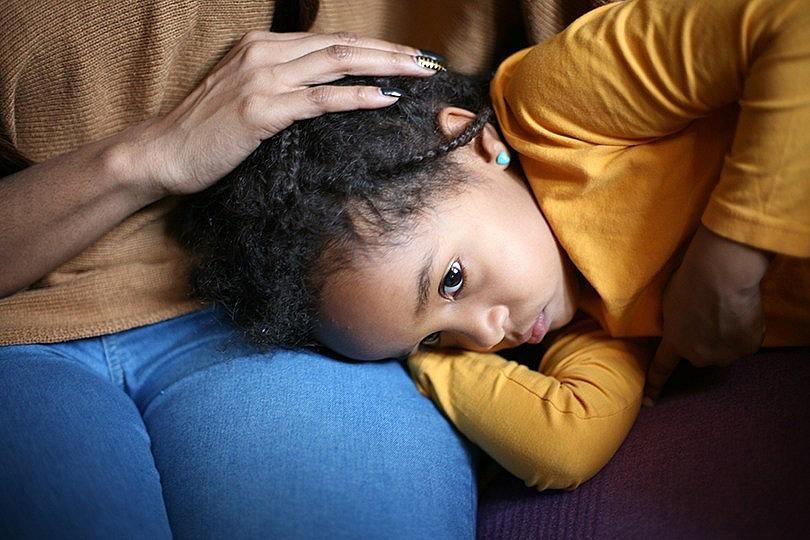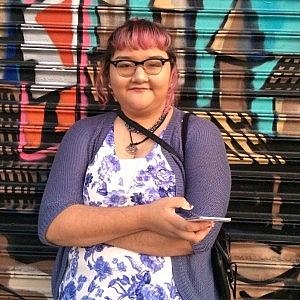Few low-income children get mental health care in California, despite need
This article was produced as a project for the 2017 California Data Fellowship, a program of the USC Annenberg Center for Health Journalism.

Mental health disorders in childhood and adolescence, including anxiety disorder, depression and attention deficit hyperactivity disorder (ADHD) are extremely common. Studies estimate between 13 and 20 percent of American children experience a mental disorder in a given year. Photo: iStock
Adela Carranco was just 11 years old when her mother discovered she was planning to kill herself.
Her suicidal intentions were tapped out in cold detail on her cell phone, from options for ending her life—take pills, get run over, or slit her wrists—to notes saying goodbye to loved ones.
For years, Adela’s mom, Olga Maldonado, had wondered if her daughter was in some kind of distress. Starting when she was a baby, she’d panic anytime she was left alone. And once she hit puberty, Adela became routinely aggressive and withdrawn. But each time Maldonado voiced her concerns to a doctor, they were dismissed, she said.
Then Maldonado started noticing deep gashes on Adela’s wrists. She searched her daughter’s phone and found the suicide plans. A visit to a crisis center and later a therapist produced a diagnosis: depression and psychosis.
“I was shocked. It was a lot of emotions trying to understand what was going on in her mind,” said Maldonado, who lives in San Francisco. “I feel like if she had been assessed earlier, the outcome would have been better.”
Mental health disorders in childhood and adolescence are extremely common. Studies estimate between 13 and 20 percent of American children experience a mental disorder in a given year. National survey data indicates that one in five children and teens will suffer a mental disorder that severely impairs daily life. Common mental illnesses include anxiety disorder, depression and attention deficit hyperactivity disorder (ADHD).
Yet research also indicates that many children in need of mental health services don’t get treatment, or suffer for years before being diagnosed. In California, the state’s key program for providing mental health treatment to low-income children and youth under age 21 serves just a fraction of those estimated to need help, statistics show. And while the pool of children potentially eligible for these services has expanded under the Affordable Care Act, the percentage of kids actually receiving help has declined since 2010, a California Health Report analysis has found.
“Kids aren’t getting what they need,” said Alex Briscoe, former director of the Alameda County Health Care Services Agency and now a consultant on health policy issues for a number of California foundations. “There are children in major counties in California with millions of residents where low-income children are not getting a service that is entitled under federal law, and a service that we now know is perhaps the most essential to their healthy growth and development.”
More Youth in Crisis, but Declining Access Rates
California provides the largest portion of its mental health care services for children and youth through a state and federally funded program called Medi-Cal Specialty Mental Health Services (SMHS). The program serves children enrolled in Medi-Cal, the state’s low-income health insurance plan, including foster youth and children involved in the juvenile justice system. More than half of California’s children are covered by Medi-Cal.
The way California delivers mental health care is unusual. Specialty Mental Health Services are “carved out” from other Medi-Cal services and administered by county mental health departments. That means people seeking these services must go through their county to get them, instead of through a Medi-Cal managed-care plan, which handles most other types of care. California is one of only three states in the country that still largely organizes mental health care in this way, said Briscoe. Other states have more integrated systems where the same entity administers both physical and mental health benefits covered by Medi-Cal, he explained.
Since 2014, California has begun to integrate some services for mild to moderate mental health problems into Medi-Cal managed care plans. However, very few children are accessing these services. According to the state Department of Health Care Services, which oversees Medi-Cal, only about 84,000 children and youth under age 21 received mental health services through managed-care plans in fiscal year 2016 to 2017. That’s just 1.5 percent of the almost 6 million children enrolled in Medi-Cal managed care.
Meanwhile, under federal law, most children and teens enrolled in Medi-Cal who have mental health disorders are eligible for specialty mental health services through the county, regardless of the severity of their complaints.
Specialty Mental Health Services cover treatment for a wide range of ailments, such as attention deficit disorders, depression, anxiety, eating disorders, antisocial personality problems, bipolar disorder and schizophrenia. Children and teens often receive multiple services through the program, depending on their needs. Some kids are hospitalized because of a mental health crisis, but are later referred for outpatient therapy or psychiatry. Adela, for example, has been to taken to psychiatric hospital several times, but also attended an adolescent day program for children with mental health issues, and received psychiatry, medication and talk therapy.
The Department of Health Care Services tracks the percentage of Medi-Cal enrolled children under age 21 who receive Specialty Mental Health Services each fiscal year.
DHCS tracks two types of access rates: those counting youth who had at least one contact with the SMHS system in a given year, and those who had five or more contacts or “visits.”
Adela Carranco, pictured above is now 18 years old. Photo: courtesy Olga Maldonado.
Both rates reveal that consistently low numbers of children and teens are recieving mental health services, even by the most conservative standards. Advocates said the low access rate is particularly alarming for this population because poverty has been shown to increase children’s likelihood of needing mental health care.
In the 2016 to 2017 fiscal year, the latest year for which statewide data is available, 4.1 percent of Medi-Cal-enrolled children statewide came into contact with the SMHS system at least once. Six years prior, during the 2011 to 2012 fiscal year, 4.8 percent of Medi-Cal enrolled children accessed the program, the state data shows. The percentage drop is small, but represents approximately 43,000 children who potentially didn’t get care.
The rate sinks even lower for “five or more visits.” This rate, researchers agreed, most accurately captures the percentage of children who actually receive care, because it takes more than one contact with the system to get an appointment, be assessed and start receiving treatment, Thull explained.
“One visit just means that they just contacted somebody once. It could be they called a crisis line, or showed up to make an appointment and never came back,” Thull said.
Since 2011, the earliest year for which data is available, the statewide access rate for “five or more visits” for SMHS has declined from 3.7 percent of children enrolled in Medi-Cal to 3.1 percent in the 2016 to 2017 fiscal year. Again, this decline represents more than 40,000 children and youth who would be receiving services had the access rate remained at the 2011 level. That’s without considering the thousands more children who likely need mental health services but don’t receive them, according to epidemiological studies.
Given the national estimate for mental disorder prevalence in children and youth, access rates in California should be closer to 20 percent, Thull said. But even within the narrow scope of children with the highest-level mental health needs, access falls short. A recent report by the California Health Care Foundation estimated 7.6 percent of children in California—or one in 13—has a “serious emotional disturbance,” and the rate climbs to 10 percent among the state’s poorest children.
Briscoe, in Alameda County, called the DHCS measurements “an accurate representation of the underperformance of our system.”
Are Counties Sitting on Funding?
It’s not just the low percentage of children served that’s a problem. Mental health advocates said the state should be doing more to collect data on whether children are being served in a timely manner, and whether the treatment they get actually leads to improvement.
Patrick Garner, a children’s mental health expert and the founder of the group Young Minds Advocacy in San Francisco, said the state fails to collect enough data on the quality of the services kids receive.
“There’s very little information out there that tells us how well or how good are the services that are provided,” he said. “There’s some information out there that suggests there are systemic problems.”
One of those problems appears to be an over-reliance on crisis care, rather than longer-term preventative and supportive services. Hospitalizations for mental health issues among children ages 5 to 19 have risen steadily since 2007, according to Kidsdata.org. Meanwhile, the number of hours children spent in crisis stabilization increased more than 20 percent between 2011 and 2017 under SMHS, state data shows. At the same time, state data shows that the amount of time dedicated to services that can prevent a mental-health crisis—including therapeutic services, in-home behavioral health support and case management—has been decreasing. Nevertheless, in some categories of support services, more children overall are getting this type of longer-term help.
Melinda Bird, senior litigation counsel for Disability Rights California, said waiting until children are in crisis to provide them with mental health care is both expensive and ineffective. Counties are required to cover numerous non-crisis SMHS Services, but many haven’t built out the infrastructure needed to provide them, she said.
“The primary way people get services is through hospitalization,” she said. “That is a traumatic process for children and their parents, and it doesn’t fix the problem.”
“I feel like if she had been assessed earlier, the outcome would have been better,” said Olga Maldonado (pictured right) of her daughter, Adela Carranco (pictured left). Photo: courtesy Olga Maldonado.
The access rates also point to racial disparities in who gets served, particularly among Latinos. While Hispanics make up half of all Medi-Cal enrollees, the most recent “five visit” rate shows only 3 percent received SMHS. That compares to an almost 4 percent rate for white children, even though they account for just one in 10 Medi-Cal recipients. Reviewers noted the disparity in a 2017 external report on SMHS and called on state officials and other stakeholders to take action. The state Health Care Services department did not respond to a request for comment on this matter.
Health officials, researchers and advocates point to a variety of factors that could be stymieing children’s access to mental health care, including funding challenges, administrative issues and stigma. Some advocates cited the state’s decision in 2011 to reorganize funding for mental health services by giving counties a fixed amount of money for SMHS each year. Critics said the move restricted county spending on SMHS even though the program is federally mandated to serve all children who need the services, regardless of cost.
SMHS are funded through a combination of federal, state and local funds. In the 2016 to 2017 fiscal year, counties spent almost $2 billion on the services for children, up from about $1.6 billion in 2013 to 2014, according to state figures. Approximately half of the funds are reimbursed by the federal Centers for Medicare and Medicaid Services. The rest comes from state distributions to counties of sales tax, vehicle license fee and income tax revenue. Some counties also pitch in their own funds to cover services.
Yet while counties are spending more on SMHS, they’re also receiving more state money to help pay for them. Funding for California’s mental health system more than doubled between 2008 and 2017, according to the California Health Care Foundation. That includes mental health funds the state “realigned” to counties in 1991 and 2011, which have risen steadily over the past five years.
Gardner said the declining access rates don’t make sense given the increase in overall funding. He questioned whether counties have funds they are not spending. An auditor’s report earlier this year found that counties have failed to spend $2.5 billion in taxpayer money for mental health care generated from Proposition 63, which is used for certain mental health services but generally not SMHS. There has been no similar state audit of SMHS spending. The Health Care Services agency said it does not produce documents laying out how much SMHS funding counties receive, spend and have in reserves each year.
Thull and Gardner said the state is not doing enough to hold counties accountable for low access rates and ensure they provide children with quality services. Fragmentation of mental health services also makes it hard for families to figure out where and how to get care, they said.
Additionally, a dire shortage of mental health professionals, particularly child psychiatrists, is making it difficult to meet increasing demand for services, according to the 2017 external review of the SMHS program. California has fewer than 1,150 child and adolescent psychiatrists to serve more than 9 million children in the state.
‘They’re Not Alone’
In an email, Health Care Services spokeswoman Carol Sloan said some of the decline in access rates can be attributed to small, year-to-year fluctuations in the number of children accessing care in small, rural counties. Additionally, new children enrolling in Medi-Cal as a result of eligibility expansion under the Affordable Care Act and the transition of the Healthy Families program into Medi-Cal in 2013 and 2014 are not accessing Specialty Mental Health Services at the same rate as other children, she wrote.
“Overall, the majority of these counties were still excelling” in terms of access rates, she wrote, noting that several counties have rates that exceed the state average.
Sloan said the agency is also implementing new federal requirements for county mental health plans that it expects will improve access, quality and timeliness of care. The department has also increased its monitoring of county health plans and is providing them with additional technical assistance, she wrote.
Kiran Savage-Sangwan, Health Integration Policy Director with the California Pan-Ethnic Health Network, said she doesn’t buy the explanation that new Medi-Cal enrollees need less mental health care.
In fact, some data suggests the opposite, “because they’re people who haven’t previously had access to health care necessarily, they’re low-income and have some of those factors that can be challenging,” she said.
Advocates are hopeful two new assessment tools being implemented this month by the Health Care Services department will begin to provide a clearer picture of the program’s quality. Counties will now be required to measure whether children’s mental health is improving as a result of the services they receive, although it will take some time before this data can be analyzed.
As for Adela, these days she continues to wrestle with mental illness, but has received therapy, psychiatry and medication through Medi-Cal to help stabilize her condition. Now 18 years old, she said she hopes to become an advocate for other children and young people facing similar struggles.
“Every chance that I get, I try to talk to people and try to tell them my story and tell them if they’re going through something they’re not alone,” she said. “When I was younger I didn’t know that anyone else was going through anything like this.”
Maldonado, Adela’s mother, is working to create a support group for parents of children with mental illness. She works for a non-profit organization in San Francisco called Support for Families of Children with Disabilities, and said she still frequently encounters families with children who appear to have undiagnosed mental health issues.
“I don’t think children need to be at the point of committing suicide to get services,” she said.
[This story was originally published by California Health Report.]
